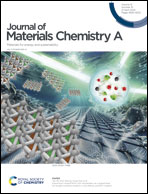Electrochemical nitrate reduction for ammonia production: amorphous or crystalline oxidized copper catalyst?†
Abstract
The electrochemical nitrate reduction reaction (NO3RR) is a promising approach to remove environmental pollutants while producing ammonia (NH3) under ambient conditions. Oxidized copper (O–Cu) with crystal structures has been widely investigated for NO3RR performance; however, its amorphous counterpart has rarely been explored. An amorphous oxidized copper (a-O–Cu) is designed to evaluate its NO3RR performance along with a control sample of crystalline oxidized copper (c-O–Cu) for comparison. At an applied potential of −0.53 V vs. RHE, a-O–Cu delivered an NH3 selectivity of 93.6% and an FE of 84.9%, which are 1.1 and 1.3 times higher than those of c-O–Cu, respectively. Density functional theory (DFT) calculations reveal that the enhanced NO3RR performance of a-O–Cu is mainly attributed to its high water dissociation capability and amorphous structure-enabled high catalytic activity. The strategy demonstrated here can be extended to design other efficient metal-based amorphous electrocatalysts for NO3RR and C–N coupling reactions.



 Please wait while we load your content...
Please wait while we load your content...